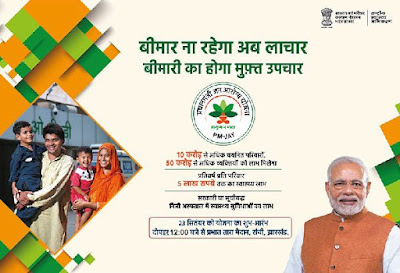Before jumping to check the eligibility for Ayushman Bharat Scheme, let us first understand the features of Ayushman Bharat Scheme or Pradhan Mantri Jan Aarogya Yojana (AB-PMJAY).
Features of Ayushman Bharat Scheme or Pradhan Mantri Jan Aarogya Yojana (AB-PMJAY): It is deemed as the world’s largest government-funded healthcare programme covering around 50 Crore beneficiaries.
The Ayushman Bharat is a scheme that aims to provide health insurance to 10 crore families.
The coverage will be Rs.5 lakh per year per family.
1,354 health packages are included in this scheme. Major treatments like coronary bypass, knee replacements and stenting would be provided at 15% to 20% cheaper rate than the Central Government Health Scheme.
The scheme provides the cashless and paperless claim process.
You can avail the benefits either in Government Hospitals or with listed private hospitals.
The beneficiaries are identified based on the deprivation categories (D1, D2, D3, D4, D5 and D7). For urban areas, 11 occupational criteria will determine the eligibility.
Here, family means no restriction on number of members or age.
As of now, Aadhaar card is not mandatory. You just have to prove your identity through Aadhaar, Voter ID or Ration Card.
Each empanelled hospital will have the “Ayushman Mitra Help Desk”, where the beneficiary can check the eligibility and enroll for the scheme.
All beneficiaries will get the QR Code. This will help in identifying the beneficiary.
Who is eligible for Ayushman Bharat Scheme?
Rural Areas
1. Households living in only one room with kucha walls and kucha roof.
2. Households with no adult member between age 16 to 59
3. Female headed households with no adult male member between age 16 to 59
4. Households having at least one disabled member and no able-bodied adult member
5. SC/ST households
6. Landless households deriving major part of their income from manual casual labour
7. Households without shelter
8. Destitute/ living on alms
9. Manual scavenger families
10. Primitive tribal groups
11. Legally released bonded labour
Urban Areas
1. Rag picker
2. Beggar
3. Domestic worker
4. Street vendor/ Cobbler/hawker / Other service provider working on streets
5. Construction worker/ Plumber/ Mason/ Labour/ Painter/ Welder/ Security guard/ Coolie and another head-load worker
6. Sweeper/ Sanitation worker / Mali
7. Home-based worker/ Artisan/ Handicrafts worker / Tailor
8. Transport worker/ Driver/ Conductor/ Helper to drivers and conductors/ Cart puller/ Rickshaw puller
9. Shop worker/ Assistant/ Peon in small establishment/ Helper/Delivery assistant / Attendant/ Waiter
10. Electrician/ Mechanic/ Assembler/ Repair worker
11. Washer-man/ Chowkidar

